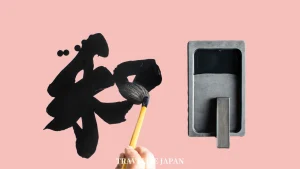Curious about mastering Kanji in Japanese? Explore the core of Kanji, Chinese characters integral to Japanese. This guide highlights origins, structure, and meanings across JLPT levels N5 to N1, showcasing how Kanji deepens insights into Japan’s language and culture. Perfect for enhancing your linguistic journey and cultural understanding.
Historical Roots of Kanji in Japan

Kanji, meaning “Han characters,” originated from ancient Chinese writing and made its way to Japan around the 5th century. This introduction marked a significant turning point in Japanese history, as it provided a written form to the Japanese spoken language, which previously lacked a script. The adaptation of Kanji in Japan was not just a linguistic import but also a cultural infusion, influencing various aspects of Japanese society.
Over the centuries, the use of Kanji in Japan evolved to suit the linguistic structure of Japanese, creating a unique system that intertwined native Japanese words with the imported Chinese characters. This historical amalgamation of Kanji within the Japanese language is a testament to the dynamic nature of linguistic evolution and cultural exchange.
Deciphering the Structure and Vastness of Kanji
Kanji are logographic characters, each encapsulating a meaning or a concept. The complexity of Kanji is evident in its structure and the sheer number of characters. There are over 50,000 Kanji characters, though a comprehensive understanding of modern Japanese requires knowledge of about 2,000 to 3,000 of these. The Japanese Ministry of Education has designated 2,136 characters, known as the Jōyō Kanji, for daily use.
Each Kanji character consists of various strokes, arranged in a specific order. These characters are composed of radicals – smaller units that often give clues to the character’s meaning or pronunciation. The dual reading system of Kanji, comprising the ‘on’yomi’ (Chinese reading) and ‘kun’yomi’ (Japanese reading), adds another layer of complexity and richness to the language.
For learners of Japanese, familiarizing themselves with the most commonly used Kanji and their radicals is an essential step towards proficiency. Recognizing these elements not only aids in reading and writing but also enriches one’s understanding of the language’s nuances.
Kanji in Modern Japanese: Linguistic and Cultural Significance
Kanji holds a prominent place in contemporary Japanese, both linguistically and culturally. In written Japanese, Kanji is used alongside Hiragana and Katakana, playing a crucial role in conveying meaning and adding depth to the language. Its use in literature, media, names, and everyday communication underscores its importance.
Culturally, Kanji transcends mere writing. The art of calligraphy, where Kanji is elegantly penned, is a revered traditional practice, showcasing the aesthetic beauty of these characters. Kanji’s influence extends to various facets of Japanese life, embodying the country’s rich heritage and artistic expression.
Kanji by JLPT Level
The Japanese-Language Proficiency Test (JLPT) evaluates non-native speakers’ grasp of Japanese, segmented into five levels from N5 to N1. N5, the entry-level, requires knowledge of 80 kanji characters, aimed at those with 250-400 hours of study. Progressing to N4 introduces 167 kanji, delving deeper into the language. The intermediate N3 level demands familiarity with 370 kanji. N2, nearing proficiency, expands the learner’s repertoire to 368 kanji. Finally, N1, the most advanced level, challenges learners with 1,235 kanji, reflecting the extensive study and understanding of Japanese required. This structure systematically escalates learners’ kanji knowledge, essential for mastering the language.
JLPT N5 – 80 Kanji
一 七 万 三 上 下 中 九 二 五 人 今 休 何 先 入 八 六 円 出 分 前 北 十 千 午 半 南 友 右 名 四 国 土 外 大 天 女 子 学 小 山 川 左 年 後 日 時 書 月 木 本 来 東 校 母 毎 気 水 火 父 生 男 白 百 聞 行 西 見 話 語 読 車 金 長 間 雨 電 食 高
JLPT N4 – 167 Kanji
不 世 主 事 京 仕 代 以 会 住 体 作 使 借 元 兄 公 写 冬 切 別 力 勉 動 医 去 口 古 台 同 味 品 員 問 図 地 堂 場 売 夏 夕 多 夜 妹 姉 始 字 安 室 家 少 屋 工 帰 広 店 度 建 弟 強 待 心 思 急 悪 意 手 持 教 文 料 新 方 旅 族 早 明 映 春 昼 曜 有 服 朝 業 楽 歌 止 正 歩 死 注 洋 海 漢 牛 物 特 犬 理 用 田 町 画 界 病 発 的 目 真 着 知 研 社 私 秋 究 空 立 答 紙 終 習 考 者 肉 自 色 花 英 茶 親 言 計 試 買 貸 質 赤 走 起 足 転 近 送 通 週 運 道 重 野 銀 開 院 集 青 音 題 風 飯 飲 館 駅 験 魚 鳥 黒
JLPT N3 – 370 Kanji
与 両 乗 予 争 互 亡 交 他 付 件 任 伝 似 位 余 例 供 便 係 信 倒 候 値 偉 側 偶 備 働 優 光 全 共 具 内 冷 処 列 初 判 利 到 制 刻 割 加 助 努 労 務 勝 勤 化 単 危 原 参 反 収 取 受 可 号 合 向 君 否 吸 吹 告 呼 命 和 商 喜 回 因 困 園 在 報 増 声 変 夢 太 夫 失 好 妻 娘 婚 婦 存 宅 守 完 官 定 実 客 害 容 宿 寄 富 寒 寝 察 対 局 居 差 市 師 席 常 平 幸 幾 座 庭 式 引 当 形 役 彼 徒 得 御 必 忘 忙 念 怒 怖 性 恐 恥 息 悲 情 想 愛 感 慣 成 戦 戻 所 才 打 払 投 折 抜 抱 押 招 指 捕 掛 探 支 放 政 敗 散 数 断 易 昔 昨 晩 景 晴 暗 暮 曲 更 最 望 期 未 末 束 杯 果 格 構 様 権 横 機 欠 次 欲 歯 歳 残 段 殺 民 求 決 治 法 泳 洗 活 流 浮 消 深 済 渡 港 満 演 点 然 煙 熱 犯 状 猫 王 現 球 産 由 申 留 番 疑 疲 痛 登 皆 盗 直 相 眠 石 破 確 示 礼 祖 神 福 科 程 種 積 突 窓 笑 等 箱 米 精 約 組 経 給 絵 絶 続 緒 罪 置 美 老 耳 職 育 背 能 腹 舞 船 良 若 苦 草 落 葉 薬 術 表 要 規 覚 観 解 記 訪 許 認 誤 説 調 談 論 識 警 議 負 財 貧 責 費 資 賛 越 路 身 辞 込 迎 返 迷 追 退 逃 途 速 連 進 遅 遊 過 達 違 遠 適 選 部 都 配 酒 閉 関 阪 降 限 除 険 陽 際 雑 難 雪 静 非 面 靴 頂 頭 頼 顔 願 類 飛 首 馬 髪 鳴
JLPT N2 – 368 Kanji
並 丸 久 乱 乳 乾 了 介 仏 令 仲 伸 伺 低 依 個 倍 停 傾 像 億 兆 児 党 兵 冊 再 凍 刊 刷 券 刺 則 副 劇 効 勇 募 勢 包 匹 区 卒 協 占 印 卵 厚 双 叫 召 史 各 含 周 咲 喫 営 団 囲 固 圧 坂 均 型 埋 城 域 塔 塗 塩 境 央 奥 姓 委 季 孫 宇 宝 寺 封 専 将 尊 導 届 層 岩 岸 島 州 巨 巻 布 希 帯 帽 幅 干 幼 庁 床 底 府 庫 延 弱 律 復 快 恋 患 悩 憎 戸 承 技 担 拝 拾 挟 捜 捨 掃 掘 採 接 換 損 改 敬 旧 昇 星 普 暴 曇 替 札 机 材 村 板 林 枚 枝 枯 柔 柱 査 栄 根 械 棒 森 植 極 橋 欧 武 歴 殿 毒 比 毛 氷 永 汗 汚 池 沈 河 沸 油 況 泉 泊 波 泥 浅 浴 涙 液 涼 混 清 減 温 測 湖 湯 湾 湿 準 溶 滴 漁 濃 濯 灯 灰 炭 無 焼 照 燃 燥 爆 片 版 玉 珍 瓶 甘 畜 略 畳 療 皮 皿 省 県 短 砂 硬 磨 祈 祝 祭 禁 秒 移 税 章 童 競 竹 符 筆 筒 算 管 築 簡 籍 粉 粒 糸 紅 純 細 紹 絡 綿 総 緑 線 編 練 績 缶 署 群 羽 翌 耕 肌 肩 肯 胃 胸 脂 脳 腕 腰 膚 臓 臣 舟 航 般 芸 荒 荷 菓 菜 著 蒸 蔵 薄 虫 血 衣 袋 被 装 裏 補 複 角 触 訓 設 詞 詰 誌 課 諸 講 谷 豊 象 貝 貨 販 貯 貿 賞 賢 贈 超 跡 踊 軍 軒 軟 軽 輪 輸 辛 農 辺 述 逆 造 郊 郵 量 針 鈍 鉄 鉱 銅 鋭 録 門 防 陸 隅 階 隻 雇 雲 零 震 革 順 預 領 額 香 駐 骨 麦 黄 鼻 齢
JLPT N1 – 1,235 Kanji
丁 丑 且 丘 丙 丞 丹 乃 之 乏 乙 也 亀 井 亘 亜 亥 亦 亨 享 亭 亮 仁 仙 仮 仰 企 伊 伍 伎 伏 伐 伯 伴 伶 伽 但 佐 佑 佳 併 侃 侍 侑 価 侮 侯 侵 促 俊 俗 保 修 俳 俵 俸 倉 倖 倣 倫 倭 倹 偏 健 偲 偵 偽 傍 傑 傘 催 債 傷 僕 僚 僧 儀 儒 償 允 充 克 免 典 兼 冒 冗 冠 冴 冶 准 凌 凜 凝 凡 凪 凱 凶 凸 凹 刀 刃 刈 刑 削 剖 剛 剣 剤 剰 創 功 劣 励 劾 勁 勅 勘 勧 勲 勺 匁 匠 匡 匿 升 卑 卓 博 卯 即 却 卸 厄 厘 厳 又 及 叔 叙 叡 句 只 叶 司 吉 后 吏 吐 吟 呂 呈 呉 哀 哉 哲 唄 唆 唇 唯 唱 啄 啓 善 喚 喝 喪 喬 嗣 嘆 嘉 嘱 器 噴 嚇 囚 圏 圭 坑 坪 垂 垣 執 培 基 堀 堅 堕 堤 堪 塀 塁 塊 塑 塚 塾 墓 墜 墨 墳 墾 壁 壇 壊 壌 士 壮 壱 奇 奈 奉 奎 奏 契 奔 奨 奪 奮 奴 如 妃 妄 妊 妙 妥 妨 姫 姻 姿 威 娠 娯 婆 婿 媒 媛 嫁 嫌 嫡 嬉 嬢 孔 孝 孟 孤 宏 宗 宙 宜 宣 宥 宮 宰 宴 宵 寂 寅 密 寛 寡 寧 審 寮 寸 射 尉 尋 尚 尭 就 尺 尼 尽 尾 尿 屈 展 属 履 屯 岐 岡 岬 岳 峠 峡 峰 峻 崇 崎 崚 崩 嵐 嵩 嵯 嶺 巌 巡 巣 巧 己 巳 巴 巽 帆 帝 帥 帳 幕 幣 幹 幻 幽 庄 序 庶 康 庸 廃 廉 廊 廷 弁 弊 弐 弓 弔 弘 弥 弦 弧 張 弾 彗 彦 彩 彪 彫 彬 彰 影 往 征 径 徐 従 循 微 徳 徴 徹 忌 忍 志 応 忠 怜 怠 怪 恒 恕 恨 恩 恭 恵 悌 悔 悟 悠 悦 悼 惇 惑 惜 惟 惣 惨 惰 愁 愉 愚 慈 態 慎 慕 慢 慧 慨 慮 慰 慶 憂 憤 憧 憩 憲 憶 憾 懇 懐 懲 懸 我 戒 戯 房 扇 扉 扱 扶 批 抄 把 抑 抗 択 披 抵 抹 抽 拍 拐 拒 拓 拘 拙 拠 拡 括 拳 拷 挑 挙 振 挿 据 捷 捺 授 掌 排 控 推 措 掲 描 提 揚 握 揮 援 揺 搬 搭 携 搾 摂 摘 摩 撃 撤 撮 撲 擁 操 擦 擬 攻 故 敏 救 敢 敦 整 敵 敷 斉 斎 斐 斗 斜 斤 斥 於 施 旋 旗 既 旦 旨 旬 旭 旺 昂 昆 昌 昭 是 昴 晃 晋 晏 晟 晨 晶 智 暁 暇 暉 暑 暖 暢 暦 暫 曙 曹 朋 朔 朕 朗 朱 朴 朽 杉 李 杏 杜 条 松 析 枠 枢 架 柄 柊 某 染 柚 柳 柾 栓 栗 栞 株 核 栽 桂 桃 案 桐 桑 桜 桟 梅 梓 梢 梧 梨 棄 棋 棚 棟 棺 椋 椎 検 椰 椿 楊 楓 楠 楼 概 榛 槙 槻 槽 標 模 樹 樺 橘 檀 欄 欣 欺 欽 款 歓 殉 殊 殖 殴 殻 毅 毬 氏 汁 汐 江 汰 汽 沖 沙 没 沢 沼 沿 泌 泡 泣 泰 洞 津 洪 洲 洵 洸 派 浄 浜 浦 浩 浪 浸 涯 淑 淡 淳 添 渇 渉 渋 渓 渚 渥 渦 湧 源 溝 滅 滉 滋 滑 滝 滞 漂 漆 漏 漠 漫 漬 漱 漸 潔 潜 潟 潤 潮 澄 澪 激 濁 濫 瀬 災 炉 炊 炎 為 烈 焦 煩 煮 熊 熙 熟 燎 燦 燿 爵 爽 爾 牧 牲 犠 狂 狙 狩 独 狭 猛 猟 猪 献 猶 猿 獄 獣 獲 玄 率 玖 玲 珠 班 琉 琢 琳 琴 瑚 瑛 瑞 瑠 瑳 瑶 璃 環 甚 甫 甲 畔 畝 異 疎 疫 疾 症 痘 痢 痴 癒 癖 皇 皐 皓 盆 益 盛 盟 監 盤 盲 盾 眉 看 眸 眺 眼 睡 督 睦 瞬 瞭 瞳 矛 矢 矯 砕 砲 硝 硫 碁 碑 碧 碩 磁 磯 礁 礎 祉 祐 祥 票 禄 禅 禍 禎 秀 秘 租 秦 秩 称 稀 稔 稚 稜 稲 稼 稿 穀 穂 穏 穣 穫 穴 窃 窒 窮 窯 竜 竣 端 笙 笛 第 笹 筋 策 箇 節 範 篤 簿 粋 粗 粘 粛 糖 糧 系 糾 紀 紋 納 紗 紘 級 紛 素 紡 索 紫 紬 累 紳 紺 絃 結 絞 絢 統 絹 継 綜 維 綱 網 綸 綺 綾 緊 緋 締 緩 緯 縁 縄 縛 縦 縫 縮 繁 繊 織 繕 繭 繰 罰 罷 羅 羊 義 翁 翔 翠 翻 翼 耀 耐 耗 耶 聖 聡 聴 肇 肖 肝 肢 肥 肪 肺 胆 胎 胞 胡 胤 胴 脅 脈 脚 脩 脱 脹 腐 腸 膜 膨 臨 臭 至 致 興 舌 舎 舗 舜 舶 艇 艦 艶 芋 芙 芝 芳 芹 芽 苑 苗 茂 茄 茅 茉 茎 茜 荘 莉 莞 菊 菌 菖 菫 華 萌 萩 葬 葵 蒔 蒼 蓄 蓉 蓮 蔦 蕉 蕗 薦 薪 薫 藍 藤 藩 藻 蘭 虎 虐 虚 虜 虞 虹 蚊 蚕 蛇 蛍 蛮 蝶 融 衆 街 衛 衝 衡 衰 衷 衿 袈 裁 裂 裕 裟 裸 製 褐 褒 襟 襲 覆 覇 視 覧 訂 討 託 訟 訳 訴 診 証 詐 詔 評 詠 詢 詩 該 詳 誇 誉 誓 誕 誘 誠 誼 諄 請 諒 諭 諮 諾 謀 謁 謄 謙 謝 謡 謹 譜 譲 護 豆 豚 豪 貞 貢 貫 貴 賀 賃 賄 賊 賓 賜 賠 賦 購 赦 赳 赴 趣 距 跳 践 踏 躍 軌 軸 較 載 輔 輝 輩 轄 辰 辱 迅 迪 迫 迭 透 逐 逓 逝 逮 逸 遂 遇 遍 遣 遥 遭 遮 遵 遷 遺 遼 避 還 邑 那 邦 邪 邸 郁 郎 郡 郭 郷 酉 酌 酔 酢 酪 酬 酵 酷 酸 醜 醸 采 釈 釣 鈴 鉛 鉢 銃 銑 銘 銭 鋳 鋼 錘 錠 錦 錬 錯 鍛 鎌 鎖 鎮 鏡 鐘 鑑 閑 閣 閥 閲 闘 阻 阿 附 陛 陣 陥 陪 陰 陳 陵 陶 隆 隊 随 隔 障 隠 隣 隷 隼 雄 雅 雌 雛 離 雰 雷 需 霊 霜 霞 霧 露 靖 鞠 韻 響 項 須 頌 頑 頒 頻 顕 顧 颯 飢 飼 飽 飾 養 餓 馨 駄 駆 駒 駿 騎 騒 騰 驚 髄 鬼 魁 魂 魅 魔 鮎 鮮 鯉 鯛 鯨 鳩 鳳 鴻 鵬 鶏 鶴 鷹 鹿 麗 麟 麻 麿 黎 黙 黛 鼓


Conclusion
Kanji is not just an aspect of the Japanese writing system; it is a cornerstone of the Japanese language and a window into the nation’s soul. The journey to learn Kanji is a challenging yet rewarding endeavor, offering more than just linguistic skills – it provides a deeper understanding of Japanese culture and history. As students delve into the world of Kanji, they unlock the secrets of a language that is both ancient and continually evolving, reflecting the enduring spirit and depth of Japan.
\ Follow Our Community /
STUDY IN JAPAN
INQUIRE NOW
Please feel free to seek our help at NO COST.
We are looking forward to meeting you!








